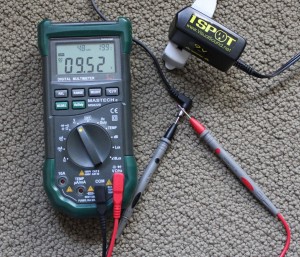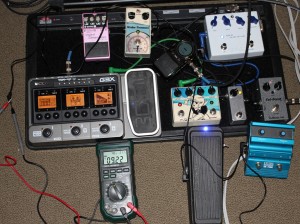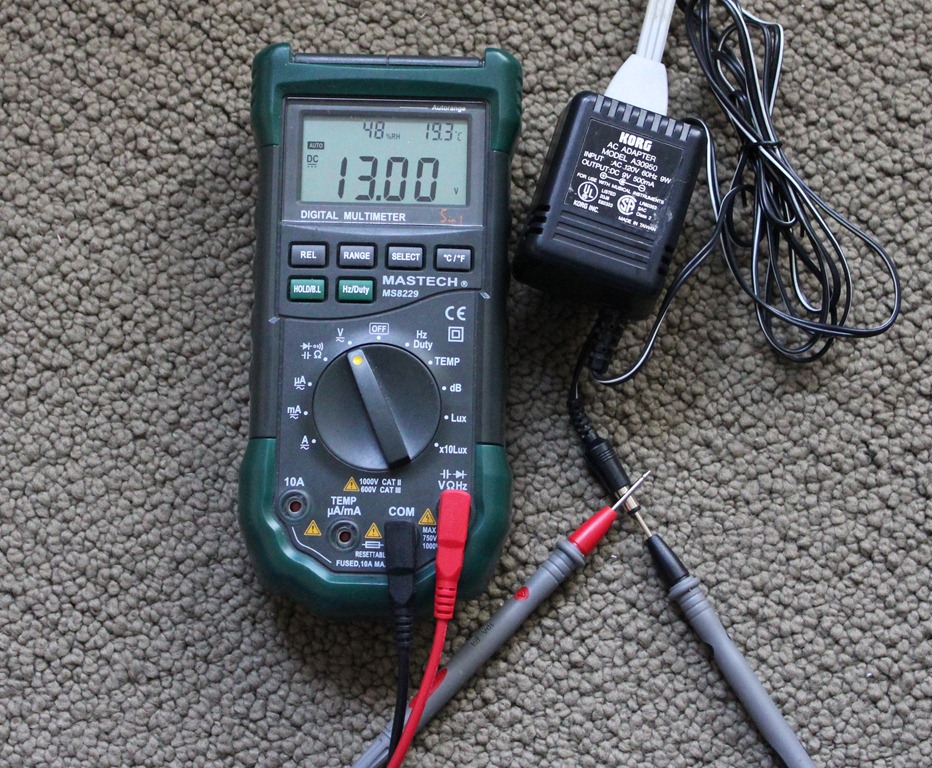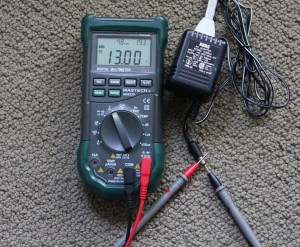When is 9V not 9V?
As I mentioned previously, my pedal board’s power supply died, so I’ve been temporarily using an old Korg 9V power supply.
I’ve been getting some hum from Ryan’s Fulltone Fat-Boost, and finally decided to do some sleuthing to figure out why.
Fortunately, before I even cracked open the Fat-Boost, I hooked up a multimeter to measure the voltage output of the Korg supply, and it turns out that this little guy is really putting out 13V, not 9V. Well, that’s annoying. Is it mislabeled, or just over-compensating for something?

Measuring the 1 Spot with the multimeter, I see this one is putting out 9.5V. I’m guessing 5.7% over is within normal tolerance for a 9V supply.
Better yet, no more hum on that Fat-Boost.
Note to future self, don’t trust power supply labels!

I set up this crazy chain of pedals, using the long daisy chain that came with the 1 Spot: tuner, compressor, wah, chorus, hush, two overdrives, two boosts, and a Zoom G3x modeler (!)
I left the final jack in the daisy chain open so I could measure it with the multimeter.
Here are the results, under this load:
- the 1 Spot power supply dropped marginally from 9.52V to 9.40V. That’s 1.3%
- the Korg power supply dropped a massive 31.6% from 13.11V to 9.96V
- for completeness, I also tried the Zoom 9V 500mA power supply (model ADS-5M-12). This one actually went up slightly from 9.12V to 9.22V (+1.01%)
So I guess the Korg power supply was probably intended to be used with a specific piece of Korg gear, and provided something near 9V when paired with that gear’s load. Clearly the 1 Spot and Zoom power supplies are better regulated.
Why didn’t I just use the Zoom power supply for the whole chain? I thought 500mA may not be enough, although it did seem to work ok in this crazy-chain test. More importantly, it seems to introduce some constant unpleasant buzzing noise in the audio signal when used with the other pedals. It works fine when paired only with the Zoom G3x.
On the other hand, the 1 Spot, with its 1700mA rating should be enough to power anything I might throw at it—I mean, how much crazier can it get? Also, interestingly, the 1 Spot did not appear to work well with the Zoom G3x modeler. While it did indeed power up and work, there was some different unpleasant noise introduced into the audio signal (noise correlated to the activity in the unit, rather than constant noise).
So for now, I’ll continue to use the Zoom G3x with its own power supply, and the 1 Spot for everything else.


Pedal Power Fiasco - Planet Z
May 22, 2013 @ 4:33 pm
[…] Update 5/22/2013: I figured out why the boost was humming- I hooked up a multimeter to that Korg power supply, and turns out that it’s really putting out 13V, not 9V. What is up with these power supply labels?! […]
May 22, 2013 @ 5:31 pm
Does the 13v power supply voltage change with a load?
May 22, 2013 @ 9:31 pm
It certainly does! I just updated my post with the results. The Korg dropped very dramatically under load. The 1 Spot behaved much better.
-John
May 22, 2013 @ 5:40 pm
measuring voltage outputs from power supplies I think is a somewhat more complicated matter, regulated supplies or not as they tend to deliver different voltages under (different) loads. Electronics also are always always made to support a range of voltage. Please go ahead and measure your 1 spot at the end after daisy-chaining 5 pedals – might be a surprise! No pedal should misbehave in any way if i.e. get fed with 12V instead of 9. If it does it’s sloppy engineering. Batteries too measure differently btw unloaded as well as loaded.
Note to the future self: if it would be easy it’d be great but it isn’t (easy) 🙂
May 22, 2013 @ 9:32 pm
You’re right- my other pedals all behaved fine with the 13V supply. Not sure what was up with the Fat Boost in that configuration- but it sure didn’t like it.
I just updated my post with some measurements under load. Interesting results!
-John
May 23, 2013 @ 2:34 am
If I remember correctly, Fat Boost is a clone of Jack Orman’s Mini Bosst (http://www.muzique.com/tech/miniboo1.htm)
Since FET’s are finicky about biasing, I would assume that one or both FETs might be mis-biassed when you supply it with 13V instead of 9V, depending on how biasing is done.
May 23, 2013 @ 8:53 am
Yes – you remember correctly- this is the original v1 FAT Boost which I’ve read was directly lifted from Jack Orman’s design. And you’re right that biasing is critical with FET boosters. I just finished building a little single-FET boost, and used a trimpot to bias the FET at exactly 4.5V. I had to adjust it when changing power supplies. My experience was that the mis-biased FET did not result in constant hum as I heard with the FAT Boost, but rather just sounded grungy and distorted (and not in a good way!)
-John
June 7, 2018 @ 12:50 am
I’ve run into this issue with the fat boost myself. It’s dependent on which version you have as to which issue dominates but it’s a combination of being a huge gain device which is then controlled by attenuation, causing horrible signal to noise ratio, and then on top of that some poor choices in circuit design. The 9v rail in mine was neither decoupled or smoothed, also mine had a source follower on the input to buffer the eq controls and the huge input impedance just makes it over sensitive to radiated noise. Running a buffer in front of mine negated this somewhat but it all gets a bit redundant as you add complexity. In fairness to Jack Orman his version is more simple and doesn’t suffer the pitfalls. There is an rg keen article on improving the biasing on these also as it massively injects resistive noise as standard. All fun learning but bloody annoying when you’re battling a frying bacon on a submarine sound on stage.
May 22, 2013 @ 8:35 pm
I knew the Fat Boost was fine! 😉
May 22, 2013 @ 9:36 pm
And you were right. 🙂 I finally built my FET booster – you can see the little guy in the updated picture- it’s between my speed racer overdrive and your fat boost.
Let’s listen to these side-by-side at next rehearsal. Maybe you can use the fat boost in your bass rig.
-John
May 23, 2013 @ 2:06 am
Great – and interesting results! I’m on tour right now in Japan and decided this time to not use a power supply at all – I’m using rechargeable Lithium 9V batteries and am very happy. Those start out at almost 13V when fully charged and fold if stretched out (with rather little warning) at around 8.7 Volts. They run any pedal for hours – I feel safe and I don’t have to deal with additional power cables and supplies.
May 23, 2013 @ 10:20 am
Interesting approach. Must be nice not having to run power up ot your pedal board. Less tripping hazards 🙂
But you have to take your batteries out to charge after every show or two? Sounds like a hassle!
One thing you may find useful, which lets you test your batteries in situ, is Keith McMillen’s Batt-O-Meter: http://www.amazon.com/exec/obidos/ASIN/B002Q0PPS4/planetz
More info here.
-John
May 23, 2013 @ 4:08 pm
Yes, I’ll daily exchange all batteries with freshly charged ones and also this approach only works by eliminating all pedals that need house power. It saves weight though and simplifies my set-up – I’m very happy with it.
The battery tester you mentioned is interesting but not necessary in my case.
I have extensive experience with rechargeable Lithium batteries. I have a stack of them and rotate them constantly so they get evenly used. It’s not a big deal. Not for everybody, but works for me. And they recharge pretty fast. I use iPower or Soshine batts. They cost about 10 bucks each and sometimes include a charger.
I also work in the film industry where we use cases and cases of 9V batteries and these batts save money fast 🙂
December 4, 2013 @ 11:24 am
here’s a warning about switch-mode type adapters. Some types couple a very low current but high AC voltage with respect to ground (that is terra firma, the ground we stand on, not the ground of the output). I have measured around half the supply voltage (120VAC on a 230VAC supply). The source is capacitive coupling from filter capacitors within the supply, and is limited to about 250uA short circuit current. Not enough to cause harm, but I have known it to destroy sensitive electronics which have been happily floating above ground… until handled.